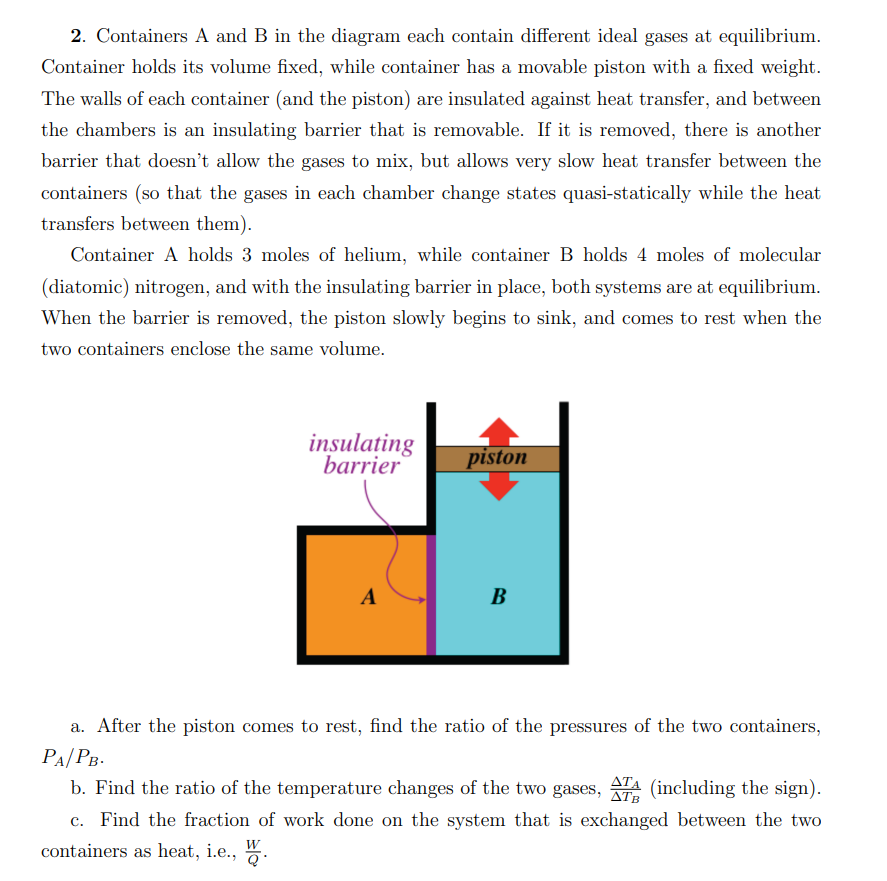2. Containers A and B in the diagram each contain different ideal gases at equilibrium. Container holds its volume fixed, while container has a movable piston with a fixed weight. The walls of each container (and the piston) are insulated against heat transfer, and between the chambers is an insulating barrier that is removable. If it is removed, there is another barrier that doesn't allow the gases to mix, but allows very slow heat transfer between the containers (so that the gases in each chamber change states quasi-statically while the heat transfers between them). Container A holds 3 moles of helium, while container B holds 4 moles of molecular (diatomic) nitrogen, and with the insulating barrier in place, both systems are at equilibrium. When the barrier is removed, the piston slowly begins to sink, and comes to rest when the two containers enclose the same volume. insulating barrier A piston B a. After the piston comes to rest, find the ratio of the pressures of the two containers, PA/PB. b. Find the ratio of the temperature changes of the two gases, ATA (including the sign). ΔΤΒ c. Find the fraction of work done on the system that is exchanged between the two containers as heat, i.e., .
2. Containers A and B in the diagram each contain different ideal gases at equilibrium. Container holds its volume fixed, while container has a movable piston with a fixed weight. The walls of each container (and the piston) are insulated against heat transfer, and between the chambers is an insulating barrier that is removable. If it is removed, there is another barrier that doesn't allow the gases to mix, but allows very slow heat transfer between the containers (so that the gases in each chamber change states quasi-statically while the heat transfers between them). Container A holds 3 moles of helium, while container B holds 4 moles of molecular (diatomic) nitrogen, and with the insulating barrier in place, both systems are at equilibrium. When the barrier is removed, the piston slowly begins to sink, and comes to rest when the two containers enclose the same volume. insulating barrier A piston B a. After the piston comes to rest, find the ratio of the pressures of the two containers, PA/PB. b. Find the ratio of the temperature changes of the two gases, ATA (including the sign). ΔΤΒ c. Find the fraction of work done on the system that is exchanged between the two containers as heat, i.e., .
Elements Of Electromagnetics
7th Edition
ISBN:9780190698614
Author:Sadiku, Matthew N. O.
Publisher:Sadiku, Matthew N. O.
ChapterMA: Math Assessment
Section: Chapter Questions
Problem 1.1MA
Related questions
Question

Transcribed Image Text:2. Containers A and B in the diagram each contain different ideal gases at equilibrium.
Container holds its volume fixed, while container has a movable piston with a fixed weight.
The walls of each container (and the piston) are insulated against heat transfer, and between
the chambers is an insulating barrier that is removable. If it is removed, there is another
barrier that doesn't allow the gases to mix, but allows very slow heat transfer between the
containers (so that the gases in each chamber change states quasi-statically while the heat
transfers between them).
Container A holds 3 moles of helium, while container B holds 4 moles of molecular
(diatomic) nitrogen, and with the insulating barrier in place, both systems are at equilibrium.
When the barrier is removed, the piston slowly begins to sink, and comes to rest when the
two containers enclose the same volume.
insulating
barrier
A
piston
B
a. After the piston comes to rest, find the ratio of the pressures of the two containers,
PA/PB.
b. Find the ratio of the temperature changes of the two gases, ATA (including the sign).
ΔΤΑ
ΔΤΒ
c. Find the fraction of work done on the system that is exchanged between the two
containers as heat, i.e., W.
Expert Solution
This question has been solved!
Explore an expertly crafted, step-by-step solution for a thorough understanding of key concepts.
This is a popular solution!
Trending now
This is a popular solution!
Step by step
Solved in 2 steps with 4 images

Knowledge Booster
Learn more about
Need a deep-dive on the concept behind this application? Look no further. Learn more about this topic, mechanical-engineering and related others by exploring similar questions and additional content below.Recommended textbooks for you

Elements Of Electromagnetics
Mechanical Engineering
ISBN:
9780190698614
Author:
Sadiku, Matthew N. O.
Publisher:
Oxford University Press

Mechanics of Materials (10th Edition)
Mechanical Engineering
ISBN:
9780134319650
Author:
Russell C. Hibbeler
Publisher:
PEARSON

Thermodynamics: An Engineering Approach
Mechanical Engineering
ISBN:
9781259822674
Author:
Yunus A. Cengel Dr., Michael A. Boles
Publisher:
McGraw-Hill Education

Elements Of Electromagnetics
Mechanical Engineering
ISBN:
9780190698614
Author:
Sadiku, Matthew N. O.
Publisher:
Oxford University Press

Mechanics of Materials (10th Edition)
Mechanical Engineering
ISBN:
9780134319650
Author:
Russell C. Hibbeler
Publisher:
PEARSON

Thermodynamics: An Engineering Approach
Mechanical Engineering
ISBN:
9781259822674
Author:
Yunus A. Cengel Dr., Michael A. Boles
Publisher:
McGraw-Hill Education

Control Systems Engineering
Mechanical Engineering
ISBN:
9781118170519
Author:
Norman S. Nise
Publisher:
WILEY

Mechanics of Materials (MindTap Course List)
Mechanical Engineering
ISBN:
9781337093347
Author:
Barry J. Goodno, James M. Gere
Publisher:
Cengage Learning

Engineering Mechanics: Statics
Mechanical Engineering
ISBN:
9781118807330
Author:
James L. Meriam, L. G. Kraige, J. N. Bolton
Publisher:
WILEY